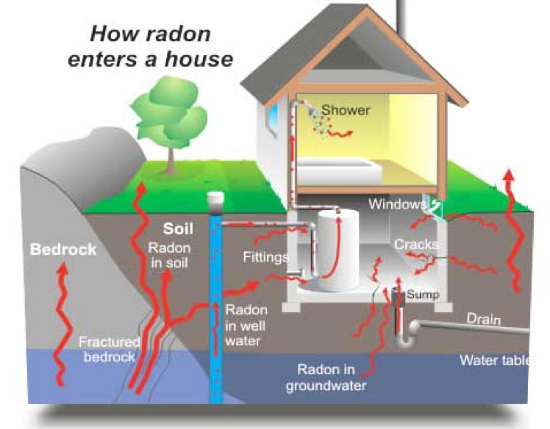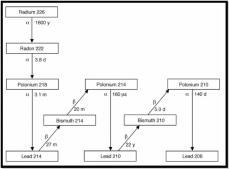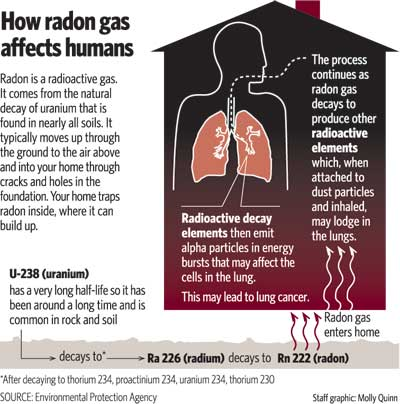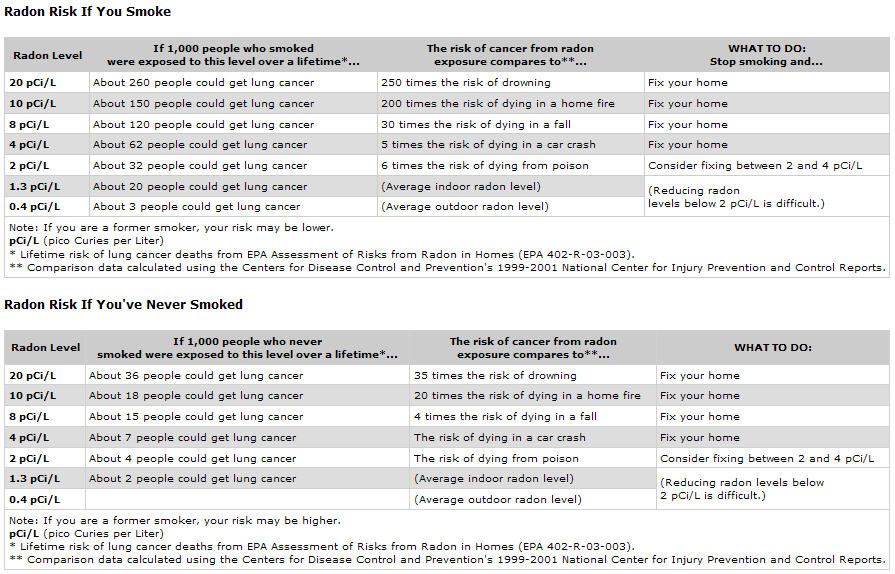
Source: Radon is a gas that is constantly being created from the decay of naturally occurring uranium and radium in the soil. Radon that is created in the soil can find its way to the surface and either enter the atmosphere or your home.
Pathways: As a gas, radon acts just like the air does. It freely moves through the open spaces in the soil. These open spaces can be as small as the space between individual particles of dirt in the soil. These open spaces can be as small as the space between individual particles of dirt in the soil. The larger the particle size of the soil, the larger the space openings will be (e.g., gravel versus sand) and therefore it will be easier for radon to move up through the soil.
Basic Physics: Although there are several different isotopes of radon, the one that is of greatest concern as a potential human health threat is called radon-222. Radon-222 is formed naturally during a chain of radioactive disintegration reactions (decay series). The decay series begins when uranium-238 decays. Uranium is widely distributed in rocks and soils throughout the earth’s crust. It has a half-life of 4.5 billion years, which means a very slow breakdown. Because radon is a gas, it moves freely in air spaces between rocks and in soils. It becomes a human health concern when it leaks from the underlying soil into homes and other buildings. New elements formed by radioactive disintegration reactions are called decay products. Thus, radium-226 is one of the decay products of uranium-238. Polonium-218 and lead-214 are decay products of radon-222. All of the elements in this series are solids, except radon. If it builds up to high concentrations in indoor air, radon and its decay products can be inhaled and cause lung cancer. The isotopes in the series that are most damaging to biological tissues are the polonium decay products of radon, primarily when they undergo radioactive disintegration inside the lungs.
Why Should You Reduce The Radon In Your Home?
Radon is ranked as a “Group A” carcinogen by
the United States Environmental Protection Agency (U.S. EPA. This means that it is known to cause
cancer in humans.


Who Says Radon Is A Health Hazard?
The United States Environmental Protection Agency says
in “A Citizens Guide to Radon”, radon is the
number one cause of lung cancer among non-smokers and you should fix your home if your radon level
is 4
Pico Curries per liter or higher. The United States Surgeon General Health Advisory states; “Indoor
radon gas is a national health problem. Radon causes thousands of deaths each year. Millions of
homes
have elevated radon levels. Homes should be tested for radon. When elevated levels are confirmed,
the
problem should be corrected.”
Other Agencies include; Amer. Lung Assoc., National Academy of Sciences, World Health Org.
How Do Radon Decay Products Cause Lung Cancer?
The radon decay products are very small
particles.
Many of the radon decay products stick on the walls of the air passages and lung tissue. Two of
these radon decay products are especially troublesome; polonium 218 and polonium 214. These two
particles release a high speed particle called an alpha particle. When this particle strikes lung
cells, the cells can be damaged. The damaged cells, in turn, may become changed in a way that van
eventually turn them into cancerous cells.
